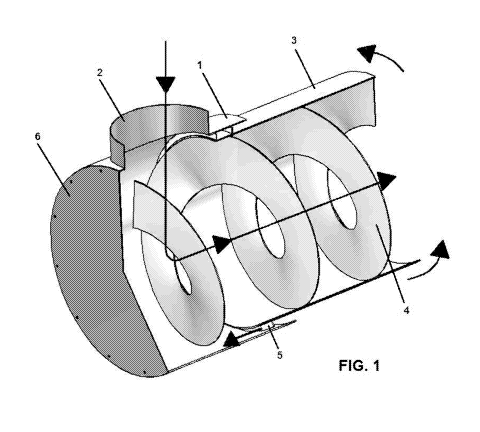Une partie des informations de ce site Web a été fournie par des sources externes. Le gouvernement du Canada n'assume aucune responsabilité concernant la précision, l'actualité ou la fiabilité des informations fournies par les sources externes. Les utilisateurs qui désirent employer cette information devraient consulter directement la source des informations. Le contenu fourni par les sources externes n'est pas assujetti aux exigences sur les langues officielles, la protection des renseignements personnels et l'accessibilité.
L'apparition de différences dans le texte et l'image des Revendications et de l'Abrégé dépend du moment auquel le document est publié. Les textes des Revendications et de l'Abrégé sont affichés :
| (12) Demande de brevet: | (11) CA 3116627 |
|---|---|
| (54) Titre français: | TAMBOUR ROTATIF POUR L'ALIMENTATION DE MATERIAU PAR GRAVITE A L'INTERIEUR |
| (54) Titre anglais: | ROTATING DRUM FOR INFEEDING MATERIAL BY GRAVITY TO ITS INTERIOR |
| Statut: | Examen demandé |
| (51) Classification internationale des brevets (CIB): |
|
|---|---|
| (72) Inventeurs : |
|
| (73) Titulaires : |
|
| (71) Demandeurs : |
|
| (74) Agent: | AIRD & MCBURNEY LP |
| (74) Co-agent: | |
| (45) Délivré: | |
| (86) Date de dépôt PCT: | 2018-10-17 |
| (87) Mise à la disponibilité du public: | 2020-04-23 |
| Requête d'examen: | 2023-10-05 |
| Licence disponible: | S.O. |
| (25) Langue des documents déposés: | Anglais |
| Traité de coopération en matière de brevets (PCT): | Oui |
|---|---|
| (86) Numéro de la demande PCT: | PCT/ES2018/070677 |
| (87) Numéro de publication internationale PCT: | WO2020/079289 |
| (85) Entrée nationale: | 2021-04-15 |
| (30) Données de priorité de la demande: | S.O. |
|---|
L'objet de la présente invention concerne un tambour rotatif pour alimenter en matières, sous l'effet de la gravité, la partie interne dudit tambour, celui-ci pouvant être utilisé aussi bien dans la partie interne d'un récipient qui pourrait être ou non soumis à une pression comme, par exemple, pour le traitement de résidus solides avec de la vapeur d'eau, qu'à l'extérieur pour tout type d'équipements qui nécessiteraient une alimentation en matières à l'intérieur du tambour rotatif pour son transport et son retournement. En raison de sa configuration spéciale, ledit tambour ne requiert pas de dispositif indépendant pour alimenter en matières le tambour rotatif.
The present invention relates to a rotating drum for gravity feeding material into its interior, which can be used either inside a pressurised or non-pressurised vessel for use in, for example, the treatment of solid waste with water vapour, or externally for all types of equipment that require the feeding of material into a rotating drum for the transportation and tumbling thereof, wherein due to the special configuration it does not require an independent device for feeding the material into the rotating drum.
Note : Les revendications sont présentées dans la langue officielle dans laquelle elles ont été soumises.
Note : Les descriptions sont présentées dans la langue officielle dans laquelle elles ont été soumises.

Pour une meilleure compréhension de l'état de la demande ou brevet qui figure sur cette page, la rubrique Mise en garde , et les descriptions de Brevet , États administratifs , Taxes périodiques et Historique des paiements devraient être consultées.
| Titre | Date |
|---|---|
| Date de délivrance prévu | Non disponible |
| (86) Date de dépôt PCT | 2018-10-17 |
| (87) Date de publication PCT | 2020-04-23 |
| (85) Entrée nationale | 2021-04-15 |
| Requête d'examen | 2023-10-05 |
Il n'y a pas d'historique d'abandonnement
Dernier paiement au montant de 210,51 $ a été reçu le 2023-10-13
Montants des taxes pour le maintien en état à venir
| Description | Date | Montant |
|---|---|---|
| Prochain paiement si taxe applicable aux petites entités | 2024-10-17 | 100,00 $ |
| Prochain paiement si taxe générale | 2024-10-17 | 277,00 $ |
Avis : Si le paiement en totalité n'a pas été reçu au plus tard à la date indiquée, une taxe supplémentaire peut être imposée, soit une des taxes suivantes :
Les taxes sur les brevets sont ajustées au 1er janvier de chaque année. Les montants ci-dessus sont les montants actuels s'ils sont reçus au plus tard le 31 décembre de l'année en cours.
Veuillez vous référer à la page web des
taxes sur les brevets
de l'OPIC pour voir tous les montants actuels des taxes.
| Type de taxes | Anniversaire | Échéance | Montant payé | Date payée |
|---|---|---|---|---|
| Taxe de maintien en état - Demande - nouvelle loi | 2 | 2020-10-19 | 100,00 $ | 2021-04-15 |
| Le dépôt d'une demande de brevet | 2021-04-15 | 408,00 $ | 2021-04-15 | |
| Taxe de maintien en état - Demande - nouvelle loi | 3 | 2021-10-18 | 100,00 $ | 2021-12-17 |
| Surtaxe pour omission de payer taxe de maintien en état pour demande | 2021-12-17 | 150,00 $ | 2021-12-17 | |
| Taxe de maintien en état - Demande - nouvelle loi | 4 | 2022-10-17 | 100,00 $ | 2022-10-07 |
| Requête d'examen | 2023-10-17 | 816,00 $ | 2023-10-05 | |
| Taxe de maintien en état - Demande - nouvelle loi | 5 | 2023-10-17 | 210,51 $ | 2023-10-13 |
Les titulaires actuels et antérieures au dossier sont affichés en ordre alphabétique.
| Titulaires actuels au dossier |
|---|
| ECOHISPANICA I MAS D MEDIOAMBIENTAL, S.L. |
| Titulaires antérieures au dossier |
|---|
| S.O. |